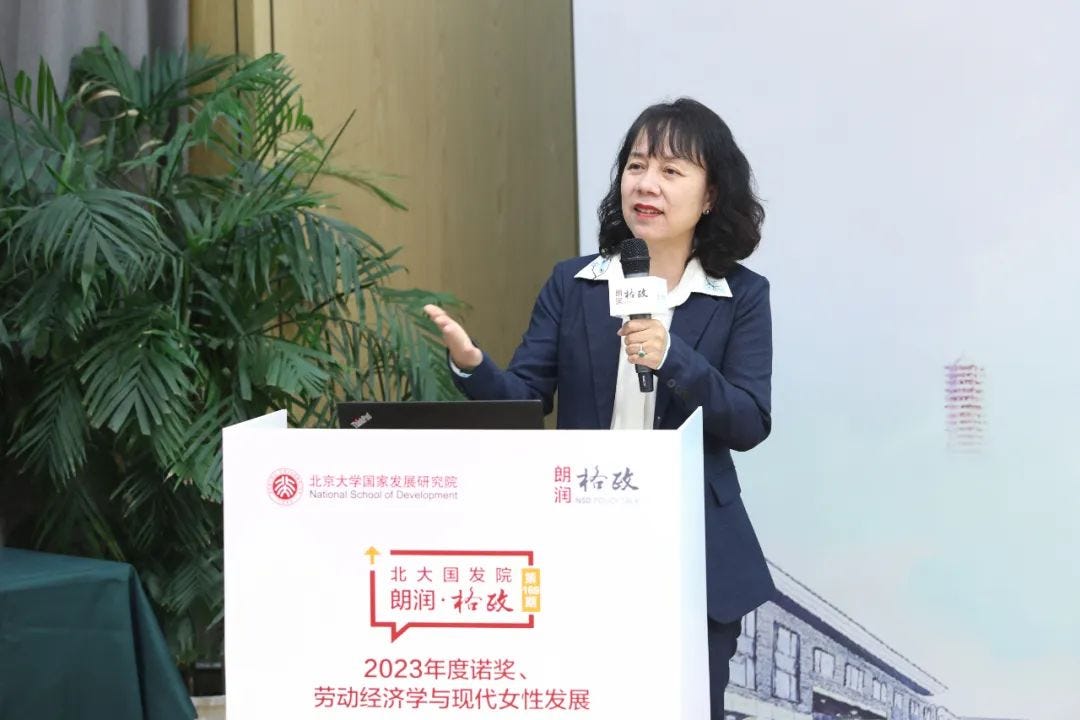Chinese women want both career and family, but inequality is pulling them away from childbearing
Peking University professor Lei Xiaoyan advocates for strengthening "cultural norms" favoring larger families and characterized by enhanced gender equality for women.
On Nov. 11, 2023, the National School of Development at Peking University hosted a session focusing on the employment and family choices of Chinese women, contextualizing the issue within China's declining birth rate and referencing the work of 2023 Nobel Laureate Claudia Goldin, who was honored for her extensive study of women's earnings and labor market participation over the centuries.
The following is the third lecture of the session, delivered by Lei Xiaoyan, a Professor of Economics from the National School of Development and the Institute for Global Health and Development at Peking University. This concise lecture is built upon statistics from the first lecture by Huang Wei, published yesterday by The East is Read, and the second lecture by Zhao Yaohui, released today by Pekingnology, which detailed Goldin's theories.
Prof. Lei's analysis underscores the substantial improvements in Chinese women's education, primarily due to educational reforms and family planning policies. However, family planning policies have also contributed to an excessively rapid decline in China's birth rates. This emerging trend requires immediate intervention to prevent it from becoming an ingrained cultural norm, said Lei. In contrast to the U.S., where household chores are more equitably shared, China still faces challenges in firmly establishing gender equality as a cultural norm.
Prof. Lei, therefore, calls for a thorough study of the costs of childbearing in China, for, as she understands, both women and men in China desire to have at least one child. Moreover, the lecture acknowledges the benefits of childbearing, albeit briefly, and suggests that future research could expand on these aspects.
The Chinese transcript of Huang's lecture is available on the official WeChat blog of the National School of Development.
Based on the research of Claudia Goldin, the 2023 Nobel Laureate, and data from China, professor Zhao Yaohui analyzed and contrasted the roles and achievements of women in professional and familial spheres in both China and the United States. Associate Professor Huang Wei focused on analyzing the cost of childbirth for women.
I would like to share my thoughts based on the presentations of both professors.
Substantial Progress has been made at the educational level of Chinese women, yet more efforts are needed to advance gender equality
Professor Zhao conducted comprehensive research on the choice of career and family. By examining factors like employment, marriage, and childbirth, she juxtaposed the conclusions of Goldin's earlier U.S.-focused research with current data from China, offering a clearer perspective on the relevant issues.
I also had several insights when reviewing Goldin's research.
First, looking at the development trajectory of the United States, women have undergone five stages of career and family choices, which is different from the situation in China. Despite the lack of detailed domestic data, it is crystal clear that the pace of education improvement of Chinese women, employment rate growth, and fertility rate decline are relatively faster. Undoubtedly, policy played a significant role in this process.
The swift enhancement of women's education in China can be attributed to educational reforms (compulsory education and expansion of university admissions), which provided women with increased educational opportunities. This advancement was also influenced by the family planning policy, designed to limit family size. With the norm of one child per family, resources could be more equitably allocated, reducing gender disparity in educational investments. Families with a single daughter became instrumental in rapidly elevating the educational level of Chinese women. Furthermore, the family planning policy was a pivotal factor in reducing China's birth rate to its current level. It is noteworthy, however, that birth rates tend to decline even in countries without such policies, but in China, this policy significantly expedited the decline, marking the "rapidity" as a unique characteristic of the Chinese experience.
However, it has now become imperative to take prompt action to reverse the decline in birth rates. Why is that? Because it involves the reshaping of childbirth culture. Childbirth practices could become a cultural norm, which, once established, could be difficult to change on issues such as the role of men and women and gender discrimination. If the practice of having only one child or no children becomes a cultural norm, it is unlikely to reverse the trend. Therefore, prompt action is imperative to achieve better outcomes.
Second, traditional gender discrimination notions are also experiencing rapid changes during this process. Today, Chinese women "hold up half the sky," [quote by Mao Zedong] indicating the huge progress made by Chinese society. However, solidifying this equality into a stable cultural norm requires even greater effort. This is something I gained from the comparison between China and the United States.
Third, data shows that only a small proportion of women choose to remain unmarried for life, while the majority still hope to marry and have at least one child. Childbearing is not only a woman's expectation; in fact, men often harbor a stronger desire for marriage and offspring, as they have always had the responsibility of continuing the family lineage. It's a sign of progress that nowadays women have caught up with men in education and employment, so they can make equal contributions to the labor market and economic development. Women have become more independent and are more empowered to say "no". If both sides wish to marry and have children, then women must be treated better.
Fourth, we can see that American women are currently in the fifth stage of "career and family." In this stage, equality, especially in sharing household chores, is a crucial factor. Being in an equal environment is conducive for women to pursue both career and family. Nowadays, Chinese women's education has developed to such a level that they not only aspire for career performance but also family fulfillment. They are all looking forward to entering the fifth stage that the United States is currently in. However, there's still a long way to go. I hope that in the future, more efforts will be made in this regard to achieve the goal of entering the fifth stage without going through detours or alternative paths.
The cost of childbearing requires a more meticulous evaluation, especially on how it impacts men and women differently.
Associate Professor Huang Wei's assessment of childbearing costs has been extensively studied internationally but relatively less so in China. In his lecture, he used econometric methods to try to identify the causality that truly affects childbirth decisions. This assessment is crucial as it helps us contemplate how to increase birth rates in a situation where women already occupy a significant portion of the labor market. Understanding the gender disparity in the costs of childbearing is crucial in recognizing the responsibilities and pressures borne by women. This is important because, as I mentioned earlier, women make choices based on their personal circumstances. Such research allows more people, especially men and male family members, to see the crux of the problem. Only by recognizing these problems can we enact changes and implement effective measures to genuinely increase the fertility rate.
I also want to propose some topics to discuss.
First, regarding the measurement of costs. Associate Professor Huang Wei has already detailed the comparison between opportunity costs and direct costs, mainly focusing on opportunity costs. However, these measurements are still not comprehensive enough. For instance, household chores are actually acting as a more significant cost in terms of gender disparity. According to existing data, a large number of women are involved in the labor market, but their household chores have not decreased. The cost of gender disparity, in this regard, is much higher for women than for men.
Second, Associate Professor Huang Wei's study has only discussed the costs of childbearing but ignored its benefits. Since women choose to bear children despite the hardships, evidently, this choice brings benefits. These benefits are not only advantageous for women themselves but also for men and for the entire family. These benefits, including satisfying current consumption needs and future investments for elder care, as well as fulfilling family life, are hard to quantify. The assessment will be more comprehensive if these factors can be included.
Lastly, it is important to acknowledge that while the discussion primarily addresses immediate costs, the benefits of the policy in question may extend over several decades. Therefore, various time constraints should be taken into account when conducting a cost-benefit analysis. Since the current research focus is on the differences between men and women, let's just assume that the benefits can't vary too much for both genders. Both fathers and mothers can enjoy familial joy as well as elder care in later years. Considering that the benefits are equally accessible to both genders, assessing even the mere cost differences gains particular relevance.
First & second lecture:
Calculating the cost of childbearing in China: the formidable factor behind country's dwindling birth rate
On Nov. 11, 2023, the National School of Development at Peking University hosted a session on the employment and family choices of Chinese women. This event took place amid the escalating challenge of China's declining birth rate, which resulted in a








